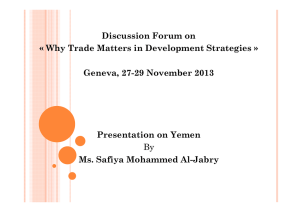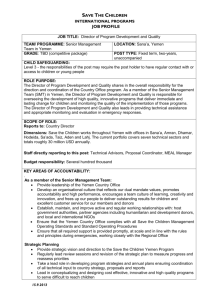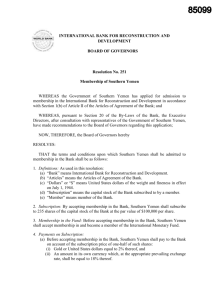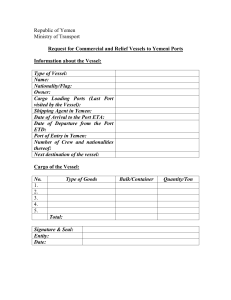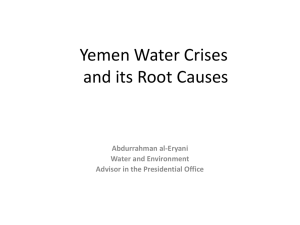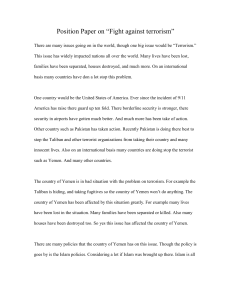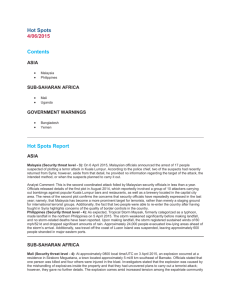Forum on “Why Trade Matters in Development Strategies?” Paper on Yemen
advertisement
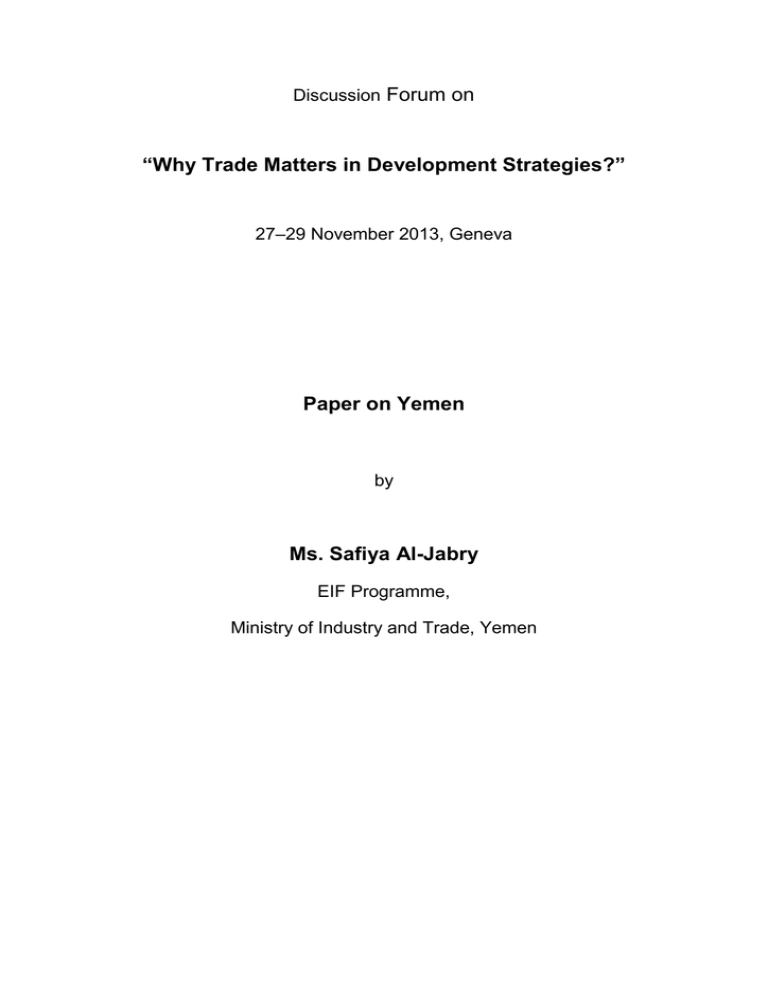
Discussion Forum on “Why Trade Matters in Development Strategies?” 27–29 November 2013, Geneva Paper on Yemen by Ms. Safiya Al-Jabry EIF Programme, Ministry of Industry and Trade, Yemen INTERGRATING TRADE IN YEMEN’S NATIONAL STRATEGIES YEMEN AT A GLANCE 1. GEOGRAPHY Yemen is located in Southwest Asia between Oman and Saudi Arabia. It is situated at the entrance of Bab-el-Mandeb, which links the Red Sea to the Indian Ocean, one of the most strategic locations in the world. Area: 203,850 square miles (527,968 km) Coastline: 1,184miles (1,906km) 2. ECONOMIC SECTORS The three main economic sectors of Yemen are oil, agriculture and fisheries Major exports include crude oil, coffee, dried and salted fish and liquefied natural gas which make up a total of US $ 7.598 billion (2012 estimates CIA World Fact Book). Major imports include food and live animals, machinery, equipment and chemicals which make up a total of UD $ 8.893 billion (2012 estimates CIA World Fact Book). Major export partners: China, Thailand, India, South Korea, Japan, US, South Africa and UAE. Major import partners: UAE, China, Saudi Arabia, Kuwait, India, US and Turkey. 3. GOVERNMENT The Yemeni government is a Republic with a double legislative body composed of the House of Representatives and the Shura Council. It is run by the Chief of State and the Head of the Government. The chief of State is the President and the Head of the Government is the Prime Minister. The country is divided into 21 governorates for local administration. 4. DEMOGRAPHICS Population: 23.58 million Population growth rate: 2.575% Urbanization: 32% of total population (2010 est) Sex ration: 1.03 males/females (2011 est) Ethnic groups: Predominantly Arab but also Afro-Arab, South Asians, Europeans Religions: Islam (Official), small number of Jews, Christians and Hindu Language: Arabic (Official) Literacy: 63.9% of the total population; 81.2% males and 46.8% females. OVERVIEW For years, Yemen has been viewed by the international community as a failing state yet it has not completely failed despite the serious political, economic and social challenges facing the country. Following the unification of South and North Yemen in 1990, the country has struggled to overcome legacy of the civil war between the North and South that broke in 1994 and to reform the economy. In 1995, Yemen launched the economic reform program in coordination with IMF to help in the economic growth of the country. Yemen’s economy prior to the 1995 economic reform program was a closed and highly protected economy characterized by high tariffs and prohibition of foreign goods with the trade policy geared towards generating revenues for the government and relatively small trade interactions with other countries. International donors put pressure on the country after 1994 crisis towards promoting reforms for the conceived failing state. However, there were no tangible results of these programs due to setbacks in the unsettling political structure which continuously backed up the poor economic situation. The political structure was characterized by domination of political and economic decisions made by tribal and military forces of the ruling structure and strong resistance in the political centre against giving concession from its Patrimony. Such ruling structure secured an optimal environment for institutional corruption that amplified during the last two decades controlling all components of the state and its economy, hence, classifying the country’s situation as state capture. By the end of 20th century, Yemen had still not created a vibrant economy nor diversified its income sources despite the launching of the economic reform program. Yemen remained a Rentier State and an importing country depending on selling its natural resources which make about 80% of the government revenue. This led to a highly fluctuating and volatile economy until 2000 when Yemen requested to join the WTO. Since then, the country changed part of its laws and trade policies in compliance with WTO global rules for the accession process. In 2001, Yemen joined the Integrated Framework later came to be known as the Enhanced Integrated Framework, an instrument to create wealth and fight poverty. Yemen undertook a Diagnostic Trade Integration Study (DTIS) that was validated in 2003 and approved by the cabinet in 2004 with issues related to WTO accession included in the Poverty Reduction Strategy Paper (PRSP) in 2003. During the period of 2000-2010, Yemen strived to implement plans and strategies at the macro and sectoral levels including the Five Year Development Plan (2001-2005), Poverty Reduction Strategy, the third National Development Plan for Poverty Reduction (2006-2010) and the National Reforms Agenda in order to achieve the Millennium Development Goals (MDGs) by 2015. Some of these plans were hindered by the conflicts of 2011 which resulted in deterioration of the country’s economy. The prospects for the future of Yemen are still unpredictable after the 2011 revolution which forced the country to go into a political transition brokered by the Gulf cooperation Council (GCC) that saw the formation of an interim government in the early presidential elections of 2012. The transition has so far advanced slower than planned. Yemenis are anticipating positive results from the on-going national dialogue that started in March 2013 and was supposed to end in September 2013. It consists of 565 members from relevant societal groups. The dialogue is meant to produce recommendations and action plans that will be instrumental for the drafting of the new constitution followed by legislative and presidential elections. This transition is seen as the best chance for the generation to make progress towards a more secure and prosperous future yet if it fails, Yemen could be facing possible state failure, large scale conflict and a humanitarian catastrophe. Following the decades of the different regimes, conflicts, political and economic turmoil, Yemen still finds itself in the highest level of poverty in the Middle East and faces deep development challenges including a weak and poorly managed economy despite its strategic location that once put Yemen as the centre of civilization and wealth. The country depends on declining oil reserves, faces corruption, high poverty level, lack of employment and poor education level. It also faces challenges from secessionists, unruly tribes, Islamist extremists and challenges in water and food security, high population growth, poor health facilities and almost non-existent service provision. Many of the problems are rooted in the government’s lack of accountability to Yemeni citizen’s and the weak rule of law where judicial system is subject to political pressure. The civil service is subject to corruption due to underpayment of the overstaffed employees. Yemen has the advantage of its diversified diaspora throughout the world that is not being utilized. Many of the diaspora are interested in investing in a secure and regulated environment yet the weak enforcement of contracts and disrespect of property rights makes investment highly unattractive. The security situation in Yemen is serious with the increasing number of reported conflicts by AlQaeda in the Arabian Peninsula which represent significant local, regional and international threat. This security situation makes it difficult for donor organizations like the World Bank, DFID, United Nations, International Monetary Fund, European Union, United States Aid and other bilateral donors as well as humanitarian agencies to implement and monitor their programs. ECONOMIC SITUATION Key Indicators: Population: 23.58 million GDP: $36.65 billion GDP growth: 0.1% Inflation: 17.3% Poverty Rate: 27.5% Per capita income: $1,820 Human Dev. Index: 0.46 Yemen is a Rentier State that highly depends on selling its natural resources to generate revenues. The country tried to diversify its economy through bolstering non-oil sector and foreign investment. In 2009, the country exported its first liquefied natural gas. In 2010, the international community established the Friends of Yemen group to support Yemen’s efforts towards political and economic reforms. Legal reforms in the economic field took place in 2009-2012 but were offset by setbacks in the political arena. The government of Yemen initiated an economic reform program in 2006 but declining oil production, terrorist attacks, kidnappings, tribal rivalries and water shortages greatly weakened tourism, foreign investment and growth. Reform initiatives like the National Agenda for Reform, related to management, economic and political issues or the Ten priorities of 2009, which mainly focuses on economic issues, have yielded minimal results. One main challenge hindering economic development is the centralization of economic decisions which has been one of the driving forces towards the rising discontent in the south against “northern domination.” This has put the government in a difficult position and the hopes for a federal state and a decentralized economy following the proposed Yemen Economic Vision 2030 to the national dialogue stand as an option to these woes. The revolution of 2011 offers hope for the country in seeing a new constitution written and the country developing in the future. The revolution is meant to dissolve the patrimony that has so long impeded development and successful implementation of reforms. Party pluralism and decentralization have become generally accepted principles during the past decade. Opposition parties have begun to cooperate and civil society organization have grown. Consolidation of these gains will boost growth and job creation and will help the government to successfully conclude the national dialogue conference. It will also help to strengthen security and begin to implement priority fiscal and other pro-growth reforms. TRADE IN YEMEN Yemen’s 2011 exports reveal that hydrocarbons make up 90% of export value of the country. The next commodity export is fish. International development organizations have pointed fisheries and agriculture as the key non-oil sectors where immediate increase in production could be made to make Yemen a diversified export country. Free trade zones The government of Yemen has exerted efforts to strengthen its economic relations with other nations and this has been seen in more than 60 commercial and industrial agreements and protocols in trade and industry aiming at achieving sustainable economic growth, reducing trade barriers and increasing trade and investment. The current free zones in the country are the Aden Free zone and the Hodeida Free zone, which is still being developed. Yemen also joined the Greater Arab Free Trade Area (GAFTA) whose aim is to create an Arab Common Market. On January 2005, the agreement reached full trade liberalisation of goods through the full exemption of customs duties and charges granting equivalent effect amongst all members of GAFTA, except Sudan and Yemen who received exemption on granting zero tariffs until 2010 due to their LDC status. Currently, Yemeni products enter into the markets of all members of GAFTA free from duties and similar charges based on a protocol of origin. Trade Agreements Multilateral Trading System WTO: Yemen applied for WTO membership in 2000 and has since then implemented a liberal economic policy. Yemen concluded its 13 year negotiation process on September 26th 2013 and is expected to sign the accession protocols in early December at the 9th Ministerial conference in Bali. The government has liberalized foreign trade, reduced tariffs and made commitments to the WTO in customs valuation, price controls, state enterprises, technical barriers to trade and other areas. Joining the WTO will enable Yemen to open new markets for Yemeni products through the implementation of MFN and National Treatment of WTO. Discrimination against Yemeni products and unfair barriers to trade such as restrictions of Yemeni trucks to Gulf Markets and burdensome requirements will be eliminated. BILATERAL TRADE AGREEMENTS Yemen has already signed a number of international trade agreements which provide reciprocal mutual MFN treatment for Yemeni products. Recent moves towards trade liberation have reduced trade barriers within Yemen and increased access to international market, especially Gulf Markets. Yemen has also signed various economic and trade cooperation with different countries like Turkey, Bulgaria, Ethiopia and Tanzania. Bilateral trade agreements of Yemen include: • • • • • Council of Arab Economic Unity (CAEU): Yemen is an active member of the (CAEU) which was established on June 1957. It became effective in 1964 with the ultimate goal of achieving economic unity among its member states. European Union: The EU is ranked as one of Yemen’s main trading partners with the bilateral trade growing over the years through a Development Cooperation Agreement with North Yemen which was extended in 1995 to cover the entire country following 1990 unification. The relations between EU and Yemen are governed by a framework cooperation agreement which covers commercial, development and economic issues and came into force in 1998. Gulf Cooperation Council (GCC): The primary trading partners of Yemen are the GCC countries. The GCC secretariat and Yemen have signed numerous economic and commercial agreements and protocols and have established joint ministerial councils, committees and working groups to study the commercial legislative and legal aspects in Yemen and GCC states. Pan Arab Free Trade Area (PAFTA): Yemen is a member of the PAFTA that was established in 1981. The agreement is based on facilitation and development of trade among Arab states with the aim of eliminating custom duties and tariffs. Trade and Investment work Agreement (TIFA): In 2004 Yemen signed TIFA with United States creating a joint council for discussing a wide range of commercial issues and permanent dialogue with the aim of strengthening bilateral trade and investment between US and Yemen. TOOLS FOR INTERGRATING TRADE INTO YEMEN’S NATIONAL STRATEGIES Looking at the challenges facing Yemen, it is unlikely to achieve most of the Millennium Development Goals by 2015. It is clear to conclude the country’s failure to successfully integrate trade in its national strategies in the past. However, being an Arab Spring country in a transitional period, Yemen is in the process of restructuring its constitution through the National Dialogue. The transition government is not mandated to write the new constitution but are part of the constitutional reforms. Trade strategies are being formulated to comply with WTO global rules and to fit in the National Reform Agendas. Development strategies are being developed by a team for sustainable development in the national dialogue responsible for formulating future development strategies. These strategies should be seen in implementation stages by 2014/2015. A stable environment equipped with necessary tools like accession to the WTO, positive results from the national dialogue, implementation of political and economic reforms and the results of UNDAF for Yemen 2012-2015 will offer the platform for future mainstreaming of trade into national strategies as well as in the bilateral and multilateral trade assistance plans. 1. ACCESSION TO WTO Yemen’s accession to the WTO marks a major step towards liberating trade, integrating Yemen into global economy and creating easy access to global markets. Yemen has made amendments to its legislation to meet WTO requirements and to integrate its trade policies to WTO global rules. The benefits of joining the WTO will be significant, especially after Yemen being designated as an LDC by the United Nations. One main benefit of joining WTO for Yemen is opening of new markets for Yemeni products and secure market access for its importers and exporters benefiting from WTO principles of nondiscrimination and most-favoured nation. This will also improve Yemen’s business environment to attract foreign and domestic investors. 2. POST-ACCESSION ASSISTANCE PLANS The European Union has been the main supporter of Yemen throughout its process in accession to the WTO with its assistance, pre and post accession, amounting to 8 million Euros. It will continue to support throughout the successful transition of Yemen towards a full integration into the WTO system. It has also been the main supporter in the formulation of the National Export Strategy and the update of the DTIS. 3. ENHANCED INTERGRATED FRAMEWORK (EIF) Yemen joined the IF in 2001, later named the (EIF) and undertook a DTIS study that was validated and approved by the cabinet in 2004. The Aid for Trade “partnership in action” programme aims at tackling supply-side constraints to trade and mainstreaming trade into national strategies by identifying opportunities in the world market where Yemen has comparative and competitive advantages to help the country in being a more active player in the global market hence lifting it out of poverty. The EIF focuses on creating a vision on the benefits of trade and integrating them into the five year development plans. (Currently suspended and replaced by a two year economic stabilization and development program). Yemen was one of the first countries for which an EIF Tier 1 project was approved in 2009 in support of its National Implementation Arrangements (NIA) project focused on preparing a DTIS update which the Concept Note will be finalized in the final quarter of 2013 and the validation expected in the first half of 2014. The NIA also focused on the formulation and preparation of a National Export Strategy which should also be expected to be finalized during the first half of 2014. The NES is premised on promoting non-oil sector exports. The EIF is also implementing the honey sector value chain project that was identified as a top priority from the DTIS Action Matrix. Part of the project’s objective is to create a brand name for Yemeni honey, to improve the quality of the honey and to provide necessary training to bee keepers in combating bee diseases. 4. UNDAF 2012-2015 With the declining oil reserves in the country and an increasing population growth, the government of Yemen’s overall goal is “to realize sustainable economic growth to reduce poverty and employment” with the main strategy in the Development Plan for Poverty Reduction 20111015 being “to stimulate economic growth through development of non-oil sectors and reduce dependency on oil and gas.” Aligned with this, the UN decided that one of its priority areas for the UNDAF will be to support inclusive and diversified economic growth with a social dividend. The UN will provide support at the policy level to assist the government to develop gender-sensitive strategies for improving the investment climate as well as assist relevant ministers to develop relevant sector policies and strategies This priority area of the UNDAF is well aligned with the National Export strategy that focuses on bolstering non-oil sectors for exports with the aims of promoting a diversified economy. The NES has four main goals: • • • • Accommodate regional economic development needs according to their comparative advantage and specialisation to create sustainable competitive advantages Integrate regional export development needs and harmonise them to meet Yemen’s trade targets Strengthen productive and competitive capacity through value chain enhancement interventions Create the export enabling business environment. (Source: Yemen UNDAF 2012-2015) CONCLUSION Although challenges facing the country seem supreme, Yemen has proved international expectations of a failing state wrong. It has been the only country with a peaceful transition after the revolution and Yemenis are determined to keep it peaceful given their high expectations of positive results of the National dialogue and anticipation of National reform agendas that will improve the economic, political and security situations of the country. The country is on the path to recovery and development, determined to integrate its economy into the global trade system mainly through the accession to the WTO. The history of Yemen and the strategic geographic location of the country qualify it to be a trading country and the implementation of the National export strategy will gear it towards being an export country. Donor assistance plans, like the European Commission Development Strategy 2007-2013, makes clear of interventions to support economic development of Yemen. Yemen has expanded its social safety net as a response to 2011 crisis and the country security situation is under continuous development with the help of donors and the international community. Yemeni diaspora who have settled in other countries await the chance and an open door to return to their country with more knowledge, skills, expertise and huge social and financial contributions to invest given the legal reforms that will offer them a secure investing environment. This is also recognized in the Mid-Term Review of the EC Development Strategy 2007-2013 which identifies the role Public-Private Dialogues and the role of economic governance towards providing the private sector with more favourable environment for investment, export diversification, growth and innovation. Post-accession plans and promised support from donors and international community in helping the country’s political transition and successful integration to the WTO system offer a positive outlook towards an integrated economy into the global trading system.
